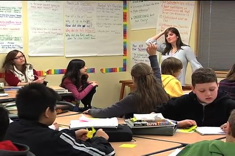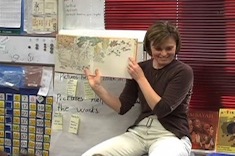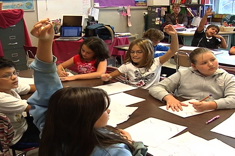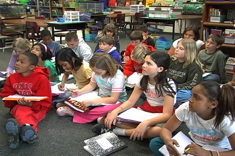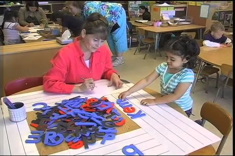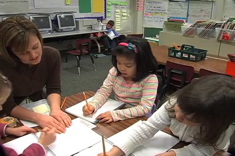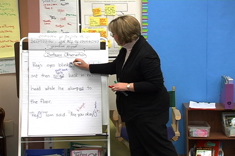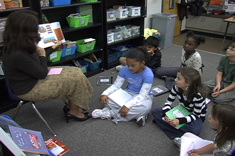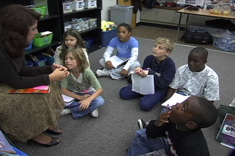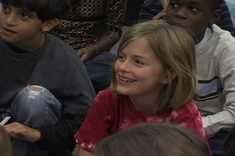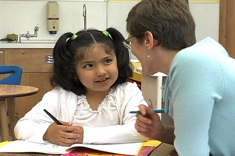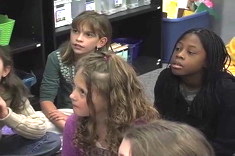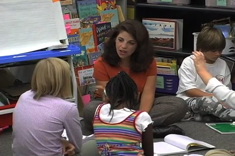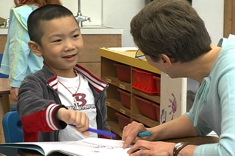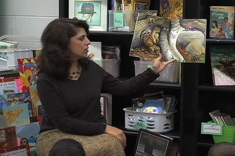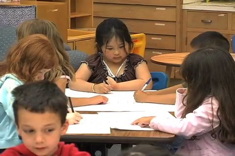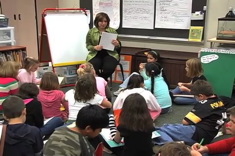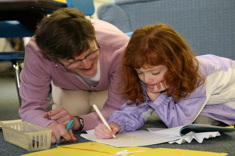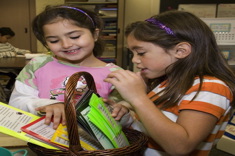Teaching Writing
Everyone who writes for Choice Literacy loves teaching writing, because we all write ourselves. We know it is "hard fun," as Donald Murray famously said—exasperating and exhilarating at the same time. The writing workshops you will read about here and see in our videos are busy, noisy, vibrant places. And most days, we wouldn't want to be anywhere else than in the midst of 'em! Here is where you'll find our latest discoveries, insights, and occasional boneheaded mistakes in teaching writing.
Latest Content
Weekend Headlines: Whole Class Share
In this final installment of a three-part video series, Katie Doherty and her sixth-grade students continue the Weekend Headlines activity. In this installment, students share their writing with the whole class and respond.
Envisioning Writing: Wow Words and Mental Images in 1st Grade
In this minilesson, Katie DiCesare uses the book My Cat Copies Me to help her first-grade students “envision” their writing drafts. The lesson focuses on creating mental images to conjure stronger verbs and adjectives while writing.
Old Elm Speaks Day 2: Connecting Poetry, Observation, and Reading
In this second installment of a three-part video series, Aimee Buckner shows how observation skills, poetry, and reading instruction come together with the mentor text Old Elm Speaks by Kristin O'Connell George.
Writing Comics: Introducing the Activity
In this lesson from a fourth-grade classroom, Sarah Thibault introduces students to a writing activity. Students will be creating their own comic books, after extensive preparation and experience with mentor texts.
Learning from Graphica: Conferring with Students
In this lesson series from a 4th grade classroom, Sarah Thibault introduces students to a writing activity. Students will be creating their own comic books, after extensive preparation and experience with graphica. In this installment, Sarah confers with students during writer's workshop as they brainstorm character traits. Students will be creating their own comic books, after extensive preparation and multiple reading and writing activities.
Learning from Graphica: Class Discussion
This is the third installment of a video series on using graphica in a 4th grade classroom. In this episode, Sarah Thibault debriefs with her class after writing workshop. Students are creating their own comic books, after extensive preparation and multiple reading and writing activities.
Sports Writing Group Discussion
Franki Sibberson finds sports writing is a powerful motivator for boys in her grades 3-4 classroom.
Nonfiction Word Hunt Part I
Word study and nonfiction reading are combined in Franki Sibberson's nonfiction word hunt activity.
Test-Taking Skills: Reading Strategies for Word Problems Part I
Question It – Know It – Show It are the keys to test preparation in Andrea Smith's 4th grade classroom.
Keeping the M
Melissa Kolb confers with three-year-old Daniela and explains why approximations are crucial for young literacy learners.
Conferring with Emily: Moving from Questions to Content
In this conference with six-year-old Emily, Ruth Shagoury looks for a way into a conversation by using Emily’s drawings, previous writing, and interests. Emily’s first language is Hmong, and she is experimenting with Chinese characters in her writing.
First Grade Guided Writing Group: Goldilocks and the 3 Writers
In this video of a first-grade guided writing group, Katie DiCesare works with three girls on spelling issues that have emerged in their writing.
5th Grade Sentence Observation
Karen Terlecky explains the sentence observation routine in her 5th grade classroom, and provides a video example of students in action analyzing sentences.
4th Grade Small Group: Writing Paragraphs
In this video, Aimee Buckner uses a mentor text to demonstrate how writers construct lively nonfiction paragraphs.
4th Grade Small-Group Lesson: Dialogue
One of the challenges of working with intermediate writers is helping them understand how and when to use dialogue in their writing. In this video of a small-group lesson, Aimee Buckner uses a mentor text and a metaphor to help her 4th grade students understand the value of using dialogue sparingly in their writing.
Coaching in Kindergarten: Conferring
What’s in a name? For kindergartner Maria, it’s the start of learning how letters and sounds work. In this coaching session, Joan Moser of “The Sisters” helps Daniel understand how to use a child’s name as a beginning point for teaching letters and sounds.
Old Elm Speaks: Connecting Poetry, Observation, and Reading
In this first installment of a three-part video series, Aimee Buckner shows how observation skills, poetry, and reading instruction come together with the mentor text Old Elm Speaks by Kristin O’Connell George.
Crafting Characters in Writer’s Workshop
If you are looking for a “peppery” heroine, Mary from The Secret Garden is one for the ages. In this video of a lesson in writer’s workshop, Franki Sibberson shows how shared text can be used to help young writers understand character traits and development.
From Compliments to Naming the Craft: Fifth-Grade Writing Workshop Share Session
This whole-class share session in Lesley Fowler’s fifth-grade classroom is the culmination of a nonfiction writing unit. Over the course of the year, students have moved from complimenting their classmates during these share sessions to writing down specific aspects of the piece they enjoyed or had questions about during the reading.
Conferring with Leonela: A Two-Day Progression
Leonela is a six-year-old student whose first language is Spanish. In these videos of conferences with Ruth Shagoury filmed over two days, she makes connections between her drawing, writing, and experiences at home and in Mexico.
Rule of 3: Writer’s Craft Whole-Class Lesson
Aimee Buckner teaches her fourth-grade students about the “Rule of 3” in writing.
Rule of 3: Mini-Group After Whole-Class Lesson
In this second video of a three-part series showing a teaching progression for the Rule of 3, Aimee Buckner has asked students who might want a little more information or help after the whole-class lesson to stay for a small group.
Rule of 3: Conferring
In this final video of a three-part series showing a teaching progression for “Rule of 3,” Aimee Buckner confers with individual students during writing workshop, checking in to see how they are applying the concept to their writing.
Conferring with Eddie
Eddie is a six-year-old student who speaks Cantonese as his first language. In this conference with Ruth Shagoury, little English is spoken, and yet there is much communication through gestures and shared history.
Listing Strategy: Minilesson
Aimee Buckner presents a listing strategy minilesson in writing workshop.
Webbing to Learn: A Writing Strategy to Chart Thinking with Young Learners
Andie Cunningham and Ruth Shagoury explain how webs can be a powerful organizing tool for kindergarten writers.
Reflection Sheets: A Tool for Assessment and Conferring
Franki Sibberson explains how “reflection sheets” work as an assessment tool in her classroom, replacing detailed notes from conferences.
Revision Tools: Providing Options to Students
From old favorites like highlighters to new resources like kangaroo bags, this whole-class session with Franki Sibberson's grades 3-4 students highlights cool tools that will inspire learners to dive in and test out different revision strategies in writer's workshop.
The Lines are to Write My Words: Phonics in Context
Ruth Shagoury considers the role of phonics in context as she observes a classroom built on a foundation of children's expert knowledge as writers.
Inviting Students to Organize Books and Materials
Debbie Miller advocates for involving children in the organization of materials for readers and writers in the classroom.
Browse Content By
Type
Category
- Assessment Tools
- Big Fresh Archives
- Booklists
- Choice Numeracy
- Classroom Design
- Common Core
- Community Building
- Conferring
- Content Literacy
- Digital Literacy
- English Language Learners
- Equity
- Family Relations
- Free Samples
- Guiding Groups
- Leadership
- Literacy Coaches
- Mentor Texts
- Minilessons
- New Teacher Mentors
- Podcasts
- Poetry
- Quote Collections
- Reading Strategies
- Self Care
- Struggling and Striving Learners
- Talking and Listening
- Teacher Study Groups
- Teaching Reading
- Teaching Writing
- Word Study and Vocabulary
Author
- Melissa Quimby
- Nawal Qarooni
- Gwen Blumberg
- Julie Cox
- The Lead Learners
- Hannah Tills
- Josie Stewart
- Ruth Metcalfe
- Mallory Messenger
- Becca Burk
- Jodie Bailey
- Vivian Chen
- Mary Brower
- Tiffany Abbott Fuller
- Stephanie Affinito
- Ruth Ayres
- Leigh Anne Eck
- Heather Fisher
- Shari Frost
- Julie Johnson
- Suzy Kaback
- Gigi McAllister
- Shirl McPhillips
- Melanie Meehan
- Cathy Mere
- Debbie Miller
- Tara Barnett and Kate Mills
- Tammy Mulligan
- Dana Murphy
- Bitsy Parks
- David Pittman
- Brenda Power
- Heather Rader
- Matt Renwick
- Mandy Robek
- Christy Rush-Levine
- Gretchen Schroeder
- Jen Schwanke
- Brian Sepe
- Katherine Sokolowski
- Stella Villalba
- Jennifer Vincent
Grade Level
Choice Literacy Membership
Articles
Get full access to all Choice Literacy article content
Videos
Get full access to all Choice Literacy video content
Courses
Access Choice Literacy course curriculum and training

